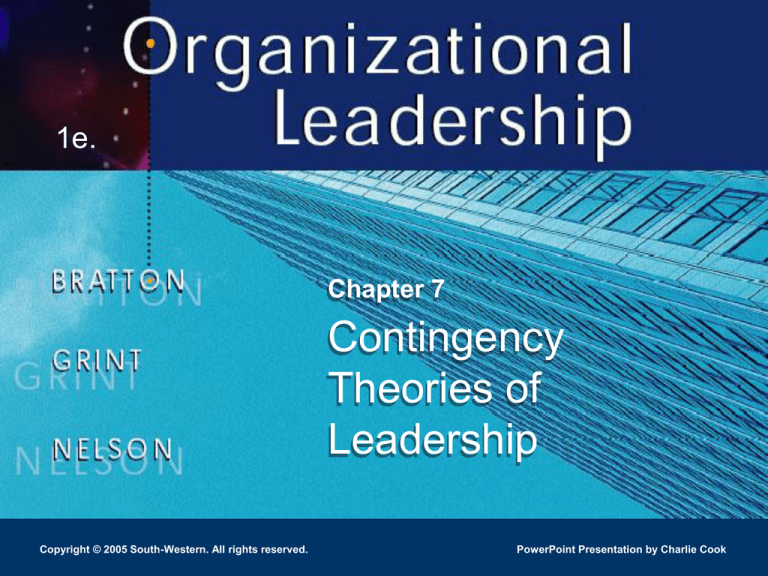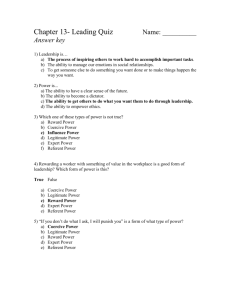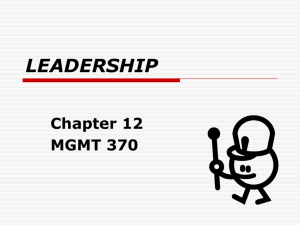
1e.
Chapter 7
Contingency
Theories of
Leadership
Copyright © 2005 South-Western. All rights reserved.
PowerPoint Presentation by Charlie Cook
Chapter Objectives
After completing this chapter, you should be able to:
Describe and distinguish among the major
contingency theories.
Understand two contemporary theories of
leadership that evolved from the contingency
theories.
Copyright © 2005 South-Western. All rights reserved.
7–2
Contingency Defined
• Contingency
Is the effectiveness of a particular strategy, structure,
or managerial style depends on the presence of
absence of other factors or forces.
Assumes that there is no one best strategy, structure,
or style. Instead, these factors must be gauged
relative to the context, circumstances, or other
factors.
Copyright © 2005 South-Western. All rights reserved.
7–3
Contingency (cont’d)
• Contingency Theories of Leadership
Propose that appropriate leader behavior depends on
certain factors, especially the situation and the
followers.
Try to specify factors, or contingency variables, that
help to determine appropriate leader behavior:
Government
action and policies.
Competitive
strategies.
Work
and organizational design changes.
Copyright © 2005 South-Western. All rights reserved.
7–4
Research Contributions
• Foundational
Studies
The Boys’ Club
studies
University of
Michigan studies
• Major Contributors
Joan Woodward
Burns and Stalker
Lawrence and Lorsch
Ohio State studies
Copyright © 2005 South-Western. All rights reserved.
7–5
Contingency Theories of Leadership
• Least Preferred Coworker Theory
Proposes that the fit between the leader’s orientation
and the favorableness of the situation determine the
team’s effectiveness in accomplishing a task.
Assumes that a leader’s style is unchangeably either
task-oriented or relationship-oriented.
Task-oriented
leaders focus on accomplishing
goals and getting work done.
Relationship-oriented
leaders focus on
developing good, comfortable interpersonal
relationships.
Copyright © 2005 South-Western. All rights reserved.
7–6
Contingency Theories of Leadership
(cont’d)
• Least Preferred Coworker (LPC) Scale
A projective technique in which a leader is asked to
think about the person with whom he or she can work
least well (the least preferred coworker, or LPC).
Classifies a leader’s orientation:
Leaders
with high (positive) LPC scores are
classified as relationship-oriented.
Leaders
with low (negative) LPC scores are
classified as task-oriented, leaders.
Copyright © 2005 South-Western. All rights reserved.
7–7
Contingency Theories of Leadership
(cont’d)
• Least Preferred Coworker Theory (cont’d)
Posits that situational factors determine which
leadership orientation will be most effective:
Task
structure refers to the rules, regulations, and
procedures in place for getting the work done.
power is the leader’s legitimate authority
to evaluate and reward performance, punish errors,
and demote group members.
Position
Leader–member
relations is an indication of the
state of the leader’s relationship with the followers.
Copyright © 2005 South-Western. All rights reserved.
7–8
Least Preferred Coworker Theory (cont’d)
Favorable Situation
Unfavorable Situation
• Highly structure task
• Unstructured task
• Strong position power
• Weak position power
• Good leader-member
relations
• Poor leader-member
relations
Situational Favorableness
Task-Oriented
Leader
(Low LPC)
Relationship-Oriented
Leader
(High LPC)
Copyright © 2005 South-Western. All rights reserved.
Task-Oriented
Leader
(Low LPC)
7–9
Contingency Theories of Leadership
(cont’d)
• Path-Goal Theory (House)
Proposes that the main task of the leader is to smooth
the follower’s path to the goal, using the appropriate
leadership behavior style to help followers clarify their
paths to both work and personal goals.
The theory draws on the expectancy theory of
motivation in considering the linkages between effort
and performance and between performance and
valued rewards to be critical to motivation.
Copyright © 2005 South-Western. All rights reserved.
7–10
Path-Goal Theory
• Leadership Styles
Directive style: the leader communicates
expectations, schedule work, and maintain
performance standards.
Supportive style: the leader expresses concern for
followers and create a supportive climate.
Participative style: the leader wants to share
decision-making authority with followers.
Achievement-oriented style: the leader sets
challenging goals, encourages high performance, and
show confidence in followers.
Copyright © 2005 South-Western. All rights reserved.
7–11
The Path-Goal Model
Source: House, R. J. (1971). “A Path-Goal Theory of Leader Effectiveness,” Administrative Science Quarterly 16, pp. 321–338;
House, R. J., and Mitchell, T. R. (1974). “Path-Goal Theory of Leadership,” Journal of Contemporary Business 3, pp. 81–97.
Copyright © 2005 South-Western. All rights reserved.
Figure 7.2
7–12
Contingency Theories of Leadership
(cont’d)
• Performance-Maintenance Theory
Holds that effective leaders exhibit two behavioral
styles:
Performance-oriented leadership behavior
Maintenance-oriented leadership behavior
The leadership styles of lower- and middle-level
managers are more important in influencing
subordinates’ performance in Japan than in the U.S.
Demonstrated that U.S. contingencies may have
limited applicability in other cultures.
Copyright © 2005 South-Western. All rights reserved.
7–13
Contingency Theories of Leadership
(cont’d)
• Normative Decision Theory (Vroom-Yetton-Jago)
Helps leaders identify appropriate decision-making
strategies in determining if, when, and how
employees should participate in the decision-making
process for a given situation.
Recognizes the benefits of authoritative, democratic,
and consultive styles of leadership behavior.
Copyright © 2005 South-Western. All rights reserved.
7–14
Normative Decision Theory
• Forms of decision making
Decide. The leader makes the decision alone
Consult (individually). The leader presents problem
for individual input, and makes the decision.
Consult (group). The leader presents problem to all
group members, gets input, and makes the decision.
Facilitate. The leader presents problem to group and
then acts as a facilitator to get concurrence.
Delegate. The leader permits the group to make the
decision within prescribed limits.
Copyright © 2005 South-Western. All rights reserved.
7–15
Reflective Question ▼
• Think of an example from business or
government in which the use of the right
decision approach worked well or the use of the
wrong one proved disastrous.
Analyze your example from a contingency
perspective.
What role did situational factors play in the success or
failure?
Copyright © 2005 South-Western. All rights reserved.
7–16
Contingency Theories of Leadership
(cont’d)
• Situational Leadership® Model
Suggests that effective leaders adjust their behavior
to the readiness of followers—the extent to which
followers demonstrate ability and willingness to
accomplish a specific task.
Ability:
the extent to which the follower possesses
the skills, experience, and knowledge needed to
perform the task without the leader’s intervention.
Willingness: the follower’s commitment,
confidence, and self-motivation to perform.
Copyright © 2005 South-Western. All rights reserved.
7–17
Situational Leadership® Model
• Situational Leadership Styles
Telling style: High concern with the task and strong
initiating structure behavior, coupled with low concern
with relationships and little consideration behavior.
Selling style: High concern with both the task and
relationships.
Participating style: High concern with relationships
and low concern with the task.
Delegating style: Low concern with the task and
relationships, because the followers accept
responsibility.
Copyright © 2005 South-Western. All rights reserved.
7–18
Reflective Question ▼
• The Hersey, Blanchard, and Johnson (2001)
model of Situational Leadership is a widely used
prescriptive approach to leadership.
Read Chapter 8, “Situational Leadership,” in their
book Management of Organizational Behavior:
Leading Human Resources, 8th ed., 2001.
What are the strengths and weaknesses of this
model?
Why do you think it is so popular among consultants
and management trainers?
Copyright © 2005 South-Western. All rights reserved.
7–19
Contingency Theories of Leadership
(cont’d)
• Leader-Member Exchange Theory (LMX)
Recognizes that leaders may form different
relationships with different followers.
Leaders form two groups of followers—in-groups and
out-groups.
Copyright © 2005 South-Western. All rights reserved.
7–20
Contingency Theories of Leadership
(cont’d)
• In-Group Members
Have characteristics similar to those of the leader.
Are given more responsibilities, rewards, and
attention.
Work within the leader’s inner circle.
Are more satisfied, have lower turnover, and have
higher organizational commitment.
Are more likely to engage in organizational citizenship
behavior.
Copyright © 2005 South-Western. All rights reserved.
7–21
Contingency Theories of Leadership
(cont’d)
• Out-Group Members
Work outside the leader’s inner circle.
Receive less attention and fewer rewards.
Are judged more harshly.
Are managed by formal rules and policies.
Are more likely to retaliate against the organization.
Copyright © 2005 South-Western. All rights reserved.
7–22
Contingency Theories of Leadership
(cont’d)
• Substitutes for Leadership Theory
Situational factors can neutralize, negate, or even
supplement any behavior by the leader.
High
task satisfaction
Performance
High
feedback
employee skill levels
Team
cohesiveness
Formal
organizational controls
Copyright © 2005 South-Western. All rights reserved.
7–23
View CD
• Go to the CD-ROM and click on the Situational
Approach button in each of the case studies.
To what extent, if at all, do the case studies support a
contingency approach to leadership?
How do the leaders involved change their leadership
styles based on the development level of their
followers and the tasks at hand?
Copyright © 2005 South-Western. All rights reserved.
7–24
Leader-Member Exchange Theory
• In Group
Exhibit characteristics
similar to leader
Viewed as trusted
collaborators
Receive more responsibility,
rewards, attention, votes of
confidence
Engage in more
organizational citizenship
behavior
Copyright © 2005 South-Western. All rights reserved.
• Out Group
Work outside the leader’s
inner circle
Managed by formal rules
and policies
Receive fewer rewards,
less attention, harsher
judgments
Viewed as hired hands
More likely to retaliate
against the organization
7–25
Substitutes for Leadership?
• Satisfying task
• Experience and ability
• Team cohesiveness
• Formal controls
• Others?
Copyright © 2005 South-Western. All rights reserved.
7–26





